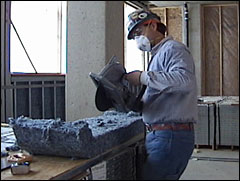Dear Umbra,
I recently discovered that our attic is not insulated. While I live in the fairly warm climate of San Diego, we’ve been hit by a cold spell the last few weeks and I’ve cranked on the heater. I’d really like to insulate my home and was wondering what is the most planet-friendly method of doing so. I know it is good to reduce energy output, but I’ve heard that the insulation itself is not so environmentally friendly. Any ideas for the average do-it-yourselfer?
Amy
San Diego, Calif.
Dearest Amy,

Six dungarees of insulation. (Photo by dnr.mo.gov.)
You’re right that insulating is, in itself, very planet friendly. I can’t think of anything jocular to say about it, because I coincidentally have that kind of head cold that feels like someone shoved insulation behind your eyeballs. But I can say that if you insulate properly, you’ll keep your house warmer during chilly periods and cooler during typical San Diego heat, and reduce your heating and cooling bills, which are a large part of the financial and environmental costs of your household.
There are many steps to take on the road to an energy-efficient home, and in this paragraph I must mention an oft-skipped beginning step, the energy audit. An energy audit is a household evaluation looking for leaks, evaluating appliances and faucets, measuring square footage against furnace BTUs, things like that. An audit is meant to focus one’s home-improvement dollars and energy toward the most effective home-improvement actions. You can either hire an audit expert, who will have special lights to shine into crevices, do an audit yourself using Lawrence Berkeley National Laboratory’s online tool, or follow the suggestions of the EERE, which I can’t be bothered to de-acronym any longer. Suffice to say they are a government agency focused on energy efficiency.
Again, insulating is such a lovely idea, really central to home efficiency, that I can’t imagine your audit would tell you not to insulate. After your audit, the next bit of assistance also comes from the acronymerific EERE. (I’ll let you in on a little secret: the EERE is usually where you should go with any home remodel question. I’m jauntier than the EERE, because I’m not a subunit of the Department of Energy, but oftentimes I jauntily point you to EERE.) The insulation section of the agency’s site will introduce you to the basic concepts, the types of insulation available, and a zip-code-based tool advising you on what R-value to buy. What’s R-value, you ask? Well, insulation works by thwarting the equalizing instincts of temperatures. Your warm living room wants to share its warmth with the attic, until the attic and living room are equal in temperature. R-value rates insulation’s ability to resist this heat generosity.
As far as materials go, fiberglass is now out of favor in the green crowd for several reasons. It is an inhalation hazard and hard to handle, what with all those tiny painful fibers. There is concern that fiberglass is the new asbestos, vis-a-vis lung damage and cancer. Some fiberglass brands contain formaldehyde, which we don’t like. Luckily, there are many other choices out there, detailed in this useful Green Home Guide comparison: pureed blue jeans, shredded newspapers, grated metal fibers, and petroleum in various guises. One they don’t mention is sheep wool. The different products will have pros and cons for your situation, including whether they come as batts or foam or loose fill and what their range of R-values is. Other factors to consider include moisture in your climate, your attic layout, your environmental priorities, and your DIY skills. Some types you would be able to install yourself, such as batts made of old jeans. Others, like blow-in fill, you can’t install yourself.
So what are my tips, in sum? Do the reading, scope out your attic even if you don’t do an entire house audit, figure out what R-value insulation you need, and pick your favorite insulation for the attic application. Decide if you can do it yourself and proceed from there. Learn from my current foggy state, though: don’t install insulation of any type behind your eyeballs.
Blearily,
Umbra

